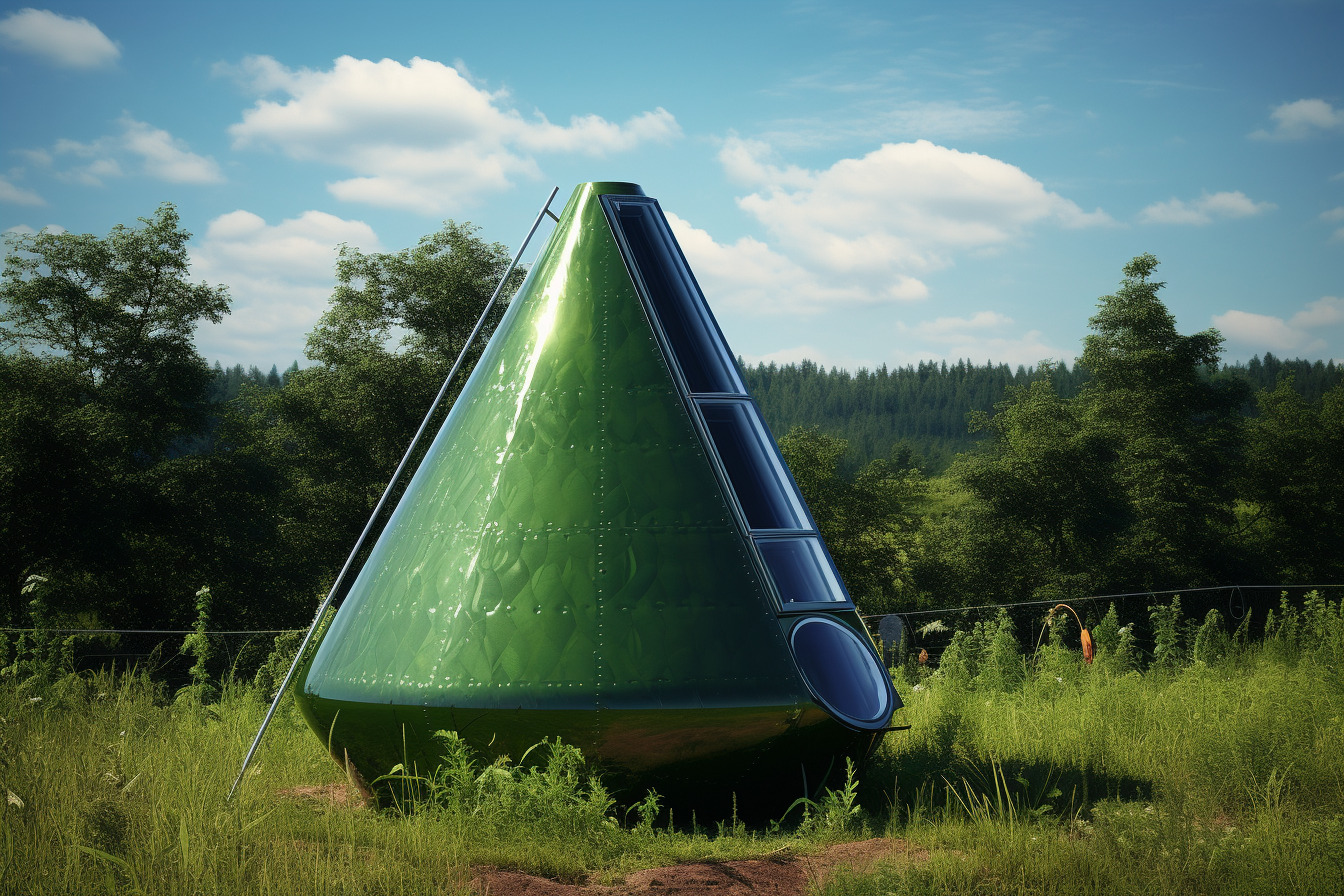
How Does a Green Cone Solar Digester Work?
We are reader-supported. When you buy through links on our site, we may earn affiliate commission.
Invented in 1988, the Green Cone is a double-walled, solar-powered biodigester that sits partially buried in the ground. Through the process of aerobic decomposition, it helps people break down their food and pet waste right at home — all without any odors. To use it, you just open the lid, add waste, sprinkle in the occasional bacteria, and close the lid again. The underground portion of the cone allows insects and microorganisms to aid in decomposition.
Why Use a Green Cone?
Waste management is a growing problem. When organic matter like food and animal feces goes to landfill, it either stays intact for years inside a plastic bag or starts breaking down immediately, giving off large quantities of methane. Neither situation is ideal.
There are 77 million dogs in the U.S., and they generate 10 million tons of poop every year. Many people use plastic bags to pick the waste up. While this method is better than leaving dog poop on the ground, it contributes to plastic pollution and still sends the feces to a landfill.
Additionally, an estimated 30% to 40% of food — much of it perfectly edible — ends up in landfills in the United States. Aside from being wasteful, disposing of that much uneaten food means landfills give off significant greenhouse gas emissions.
Green Cones break down waste aerobically. As bacteria carry out digestion, they return the carbon to the soil where it becomes part of the carbon cycle. The process does not emit gases into the atmosphere. Because these solar cones have a double-walled structure, they trap heat that speeds up the decomposition process.
What’s the Difference Between a Composter and a Digester?
A compost system produces compost — fertile, nutrient-rich soil — as a byproduct of the decomposition process. It requires the addition of carbon material like straw, paper, or leaves, and you may have to turn the material to help it break down.
In contrast, a biodigester like a Green Cone does not produce compost. Instead, the nutrients leach back into the soil as a liquid, nourishing the surrounding plants. It’s a relatively hands-free process compared to composting, which requires more active work.
Where to Install a Green Cone
Green solar cones work best in a very sunny location with good-draining soil. Chalky or clay soil may not drain well enough to let the food break down, so you can build a raised bed if you have poor drainage. It’s also important to install a Green Cone in an area with no underground cables, tree roots, or pipes since you have to dig to install it.
How to Use a Green Cone
Each Green Cone comes with a waste caddy for collecting food scraps. When the caddy is full, you take it outside and add the scraps to the Green Cone, then close the cone’s lid.
You will also need to add accelerator powder to the mix to aid digestion. How often you’ll add it depends on the outdoor temperature.
What Can Go in a Solar Cone
Green solar cones can handle a large variety of waste, including:
- Fish, poultry, and red meat
- Bones
- Crushed eggshells
- Cooked scraps
- Fruits and vegetables, including peels
- Dairy
- Teabags
- Coffee grounds
- Animal excrement
What Not to Put in a Solar Cone
Certain materials — including some you can compost — should not go in solar cones. They include:
- Paper
- Grass and straw
- Yard trimmings, including leaves and branches
- Metal
- Plastic
- Glass
- Disinfectant or bleach
- Large amounts of oil or fat
- Nutshells and seafood shells
- Medical waste
- Bags or liners
How Much Waste Can You Put in a Green Cone?
In the summer, you can add 4.5 liters of waste — a full caddy — to the Green Cone every one to two days. During winter months, the Green Cone can handle 4.5 liters every two to three days.
How to Use Accelerator Powder
Accelerator powder is a mixture of bacteria and cereal grains. The microorganisms help break down food inside the cone, so periodically adding more of them speeds up the digestion process.
You must add accelerator powder to the cone every time you use it in the winter — cold weather slows decomposition. In warmer seasons, aim to use around one packet of powder per month.
Keeping Animals Out of the Green Cone
Here are some tips to avoid attracting pests:
- Bears
Green Cones are not bear proof. If you live in bear country, you may need to install the cone in a protected area, such as surrounded by an electric fence. Another deterrent is to put cayenne pepper on the lid after each use. Additionally, it’s a good idea to wait until bacteria become well established in the cone before adding animal attractants like meat, fruit, and other strongly scented foods.
- Vermin
If you install it properly, a Green Cone won’t attract pests like mice or raccoons. Burying the top of the basket and the bottom lip of the outer cone ensures the soil will filter out any odors. Installing hardware cloth around the base of the cone can add extra security against wildlife. Additionally, taking care not to spill food on or around the Green Cone helps deter animals.
- Flies
Because the Green Cone has a seal to prevent smells from escaping, it does not attract flies. But if there are already eggs inside fruit peels — with oranges and bananas being prime locations for fruit flies to lay eggs — they may hatch inside the cone. Additionally, leaving food uncovered on the counter or table before putting it in the cone gives flies a chance to lay eggs in it.
If flies become a problem, avoid using chemical pesticides in the cone. Instead, spray the insects with an organic product that will break down in the cone over time.
Solar Cones: A Great Solution for Waste Disposal
With most people discarding a significant portion of their food, organic waste has become a huge issue worldwide. Cat and dog poop have also become an increasing problem as pet populations increase.
Green solar cones present a unique way for homeowners to process garbage, letting people reduce their carbon footprint and play an active role in waste management. Hopefully, more people will adopt Green Cones in the future.
Share on
Like what you read? Join other Environment.co readers!
Get the latest updates on our planet by subscribing to the Environment.co newsletter!
About the author
Steve Russell
Steve is the Managing Editor of Environment.co and regularly contributes articles related to wildlife, biodiversity, and recycling. His passions include wildlife photography and bird watching.





